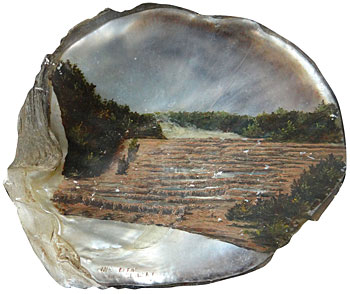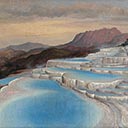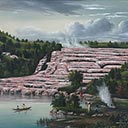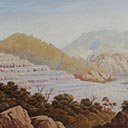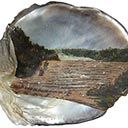Pink Terrace and White Terrace, New Zealand - A Pair
20 x 22 cm
est. $800 - 1,200
A Private Collection of Paintings, Photographs and Geological Samples of the Pink and White Terraces, Rotomahana, New Zealand
This unusual collection, reflecting a fascination with the lost Pink and White Terraces was amassed over a ten year period. It comes to the sale room from a property on the shores of Lake Tarawera.
Paintings by the German artist, William Binzer, a rare1884 work by Joseph Gaut of a Maori maiden bathing in the shadow of the Pink Terrace Umbrella Buttress are offered. Works by J D Perrett, J C Hoyte and the master of terrace portrayal, Charles Blomfield also feature. These artworks and others are complemented by a selection of original photographs by Charles Spencer, Josiah Martin and Burton Brothers Studio.
As well as artworks, a large authentic collection of geological samples from the terraces themselves is offered. They include fossilized flora and small branches embedded with silica and silica sinter formations from the collection of civil engineer and surveyor, James Stewart (1832-1914). In 1880 Stewart explored a road link from Rotorua to Cambridge, and later was involved in the planning of an early rail link from Rotorua to Morrinsville. Stewart collected the specimens prior to the eruption that destroyed the terraces in the early morning of 10 June,1886. The collection was stored at the Stewart family bach on Rangitoto Island until 1970 when it was sold to a private collector.
The Pink Terraces, or Otukapuarangi and the White Terraces, Te Tarata were natural wonders. They were destroyed by the 1886 eruption of Mount Tarawera. The Terraces were formed by geothermally heated water containing large amounts of silicic acid and sodium chloride from two large geysers. These geysers were part of a group of forty geysers in the nearby area.
The Pink and the White Terraces were nearly a kilometre apart. The White Terraces were at the north end of Lake Rotomahana and faced away from the lake at the entrance to the Kaiwaka stream. They descended to the lake edge forty metres below. The additional sunlight received from facing north created their bleached, white appearance. The Pink Terraces were about two thirds of the way down the lake, sheltered from the harsh sun on the western shores, facing south-east. Their pink appearance was largely due to less sunlight reaching them and therefore less bleaching. In February 2011 a team including researchers from New Zealand's Institute of GNS Science were mapping the lake floor when they discovered part of the Pink Terraces. The lowest two tiers of the terraces were found in their original place at a depth of sixty metres. A part of the White Terraces was rediscovered in June 2011.
To view other work in the pair, please download this PDF (105KB)

